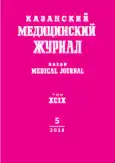The effect of testosterone on the rate of oxygen consumption by prostate tissue
- Authors: Lobkarev AO1, Khafiz’yanova RK.2, Lobkarev OA1
-
Affiliations:
- Kazan State Medical Academy, Branch Campus of the FSBEI FPE RMACPE MOH Russia “Clinic of Ambulatory Urology”
- Kazan State Medical University
- Issue: Vol 99, No 5 (2018)
- Pages: 775-778
- Section: Experimental medicine
- URL: https://journals.rcsi.science/kazanmedj/article/view/10300
- DOI: https://doi.org/10.17816/KMJ2018-775
- ID: 10300
Cite item
Full Text
Abstract
Aim. To study the effect of testosterone on the rate of oxygen consumption by rodent prostate homogenate. Methods. The study included 30 healthy old white outbred male rats divided into two groups with 15 animals in each group. The rats of the first group were administered the application of 1 % testosterone-containing gel Androgel before the operation. The rats of the second group received no testosterone. Under anesthesia prostatectomy was performed. Homogenate was immediately prepared from each prostate. Further every homogenate was placed into 250 ml vial to determine the rate of oxygen consumption. Then the device measuring the concentration of oxygen dissolved in water was placed into the vial, and the air-tightness was created. Each vial was put into the thermostat for 30 minutes at 36.6 ˚C. Then the measurement of the concentration of O2 dissolved in the water was performed. Results. Application of transdermal gel with 1 % testosterone was found to cause increase of oxygen consumption by prostate tissue. This fact can explain why the clinical effectiveness of testosterone is individual to each patient with benign prostatic hyperplasia (BPH) and chronic prostatitis (CP): oxygen supply to the prostate is different in each patient with BPH and CP. So not in every patient the oxygen-transporting system is capable of supplying prostate tissues with the amount of oxygen according to increasing demand of the organ on testosterone administration. Conclusion. Testosterone increases the rate of oxygen consumption by prostate tissue.
Full Text
##article.viewOnOriginalSite##About the authors
A O Lobkarev
Kazan State Medical Academy, Branch Campus of the FSBEI FPE RMACPE MOH Russia “Clinic of Ambulatory Urology”
Author for correspondence.
Email: Lobkarev@gmail.com
Kazan, Russia
R Kh Khafiz’yanova
Kazan State Medical University
Email: Lobkarev@gmail.com
Kazan, Russia
O A Lobkarev
Kazan State Medical Academy, Branch Campus of the FSBEI FPE RMACPE MOH Russia “Clinic of Ambulatory Urology”
Email: Lobkarev@gmail.com
Kazan, Russia
References
- Medvedev D.A. Ezhegodnoye poslaniye Prezidenta Rossiyskoy Federatsii Federal’nomu Sobraniyu. (The Annual message to Federal Assembly of the Russian Federation.) Moscow. 2009; 20 p. (In Russ.)
- Sergeev P.V., Shimanovskiy N.L. Biohimicheskije voprosy pharmakodynamiki (Biochemical issues of pharmacodynamics.) Moscow: MIA. 2010; 624 p. (In Russ.)
- Caruthers M. The testosterone revolution. London: Thorsons. 2001. Russ. ed.: Revolyutsiya testosterone. Moscow: Medpraktika-M. 2005; 224 p. (In Russ.)
- Testosterone: action, deficiency, substitution. Ed. by Eberhard Nieschlag and Hermann M. Behre, Assoc. ed. Susan Nieschlag. Cambridge University Press. 2012; 570 p.
- Krasnyak S.S. The «underwater stones» of testosterone therapy. Daidzhest urologii. 2018; 2: 26–34. (In Russ.)
- Дедов И.И., Калинченко С.Ю. Возрастной андрогенный дефицит у мужчин. М.: Практическая медицина. 2006; 240 с. [Dedov I.I., Kalinchenko S.Yu. The age-
- associated androgen deficiency in men. Moscow: Practicheskaya meditsina. 2006; 240 p. (In Russ.)]
- Onkourologiya: natsional’noe rukovodstvo. (Oncourology: the national guidelines.) Ed. by V.I. Chissov, B.Ya. Alekseev, I.G. Rusakov. Moscow: GEOTAR-Media. 2012; 688 p. (In Russ.)
- The amperometric detector of the dissolved oxygen with the thermoelectric transformator DKTP-02. The passport and the manual. Moscow. 2016; 26 p. (In Russ.)
- Khafizyanova R.Kh., Burykin I.M., Aleeva G.N. Matematicheskaya statistika v eksperimental’noy i klinicheskoy farmakologii. (Mathematical statistics in experimental and clinical pharmacology.) Kazan: Meditsina. 2006; 102–104. (In Russ.)
- Thurmond P., Yang J.H., Li Y, Lerner L.B., Azadzoi K. Structural modifications of the prostate in hypoxia, oxidative stress, and chronic ischemia. Korean J. Urol. 2015; 2: 187–196. doi: 10.4111/kju.2015.56.3.187.
- Thurmond P., Yang J.H., Azadzoi K.M. LUTS in pelvic ischemia: a new concept in voiding dysfunction. Am. J. Physiol. Renal. Physiol. 2016; 5: F738–F743. doi: 10.1152/ajprenal.00333.2015.
Supplementary files






